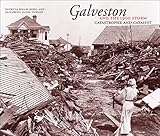Galveston and the 1900 Storm : Catastrophe and Catalyst / Elizabeth Hayes Turner, Patricia Bellis Bixel.
Material type: TextPublisher: Austin : University of Texas Press, [2021]Copyright date: ©2000Description: 1 online resource (190 p.)Content type:
TextPublisher: Austin : University of Texas Press, [2021]Copyright date: ©2000Description: 1 online resource (190 p.)Content type: - 9780292753952
- 976.4/139 21
- online - DeGruyter
| Item type | Current library | Call number | URL | Status | Notes | Barcode | |
|---|---|---|---|---|---|---|---|
 eBook
eBook
|
Biblioteca "Angelicum" Pont. Univ. S.Tommaso d'Aquino Nuvola online | online - DeGruyter (Browse shelf(Opens below)) | Online access | Not for loan (Accesso limitato) | Accesso per gli utenti autorizzati / Access for authorized users | (dgr)9780292753952 |
Frontmatter -- CONTENTS -- FOREWORD -- ACKNOWLEDGMENTS -- INTRODUCTION "A place of unique, sensual beauty" -- CHAPTER ONE "A thousand little devils, shrieking and whistling" -- CHAPTER TWO "You brave people of Galveston" -- CHAPTER THREE "Everything that mortal men can do" -- CHAPTER FOUR "To attain that superior success" -- CONCLUSION "I will never forget those days" -- BIBLIOGRAPHICAL ESSAY -- INDEX
restricted access online access with authorization star
http://purl.org/coar/access_right/c_16ec
The Galveston storm of 1900 reduced a cosmopolitan and economically vibrant city to a wreckage-strewn wasteland where survivors struggled without shelter, power, potable water, or even the means to summon help. At least 6,000 of the city's 38,000 residents died in the hurricane. Many observers predicted that Galveston would never recover and urged that the island be abandoned. Instead, the citizens of Galveston seized the opportunity, not just to rebuild, but to reinvent the city in a thoughtful, intentional way that reformed its government, gave women a larger role in its public life, and made it less vulnerable to future storms and flooding. This extensively illustrated history tells the full story of the 1900 Storm and its long-term effects. The authors draw on survivors' accounts to vividly recreate the storm and its aftermath. They describe the work of local relief agencies, aided by Clara Barton and the American Red Cross, and show how their short-term efforts grew into lasting reforms. At the same time, the authors reveal that not all Galvestonians benefited from the city's rebirth, as African Americans found themselves increasingly shut out from civic participation by Jim Crow segregation laws. As the centennial of the 1900 Storm prompts remembrance and reassessment, this complete account will be essential and fascinating reading for all who seek to understand Galveston's destruction and rebirth.
Mode of access: Internet via World Wide Web.
In English.
Description based on online resource; title from PDF title page (publisher's Web site, viewed 26. Apr 2022)


